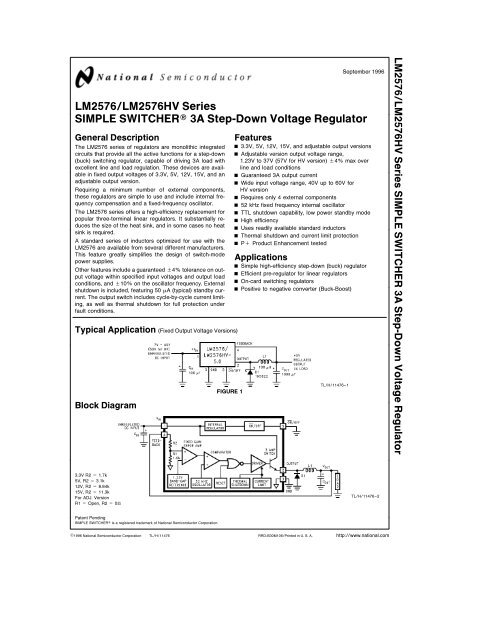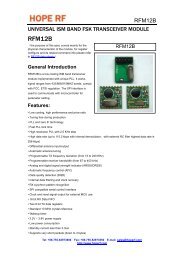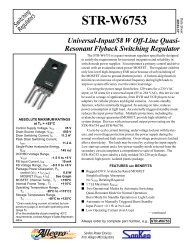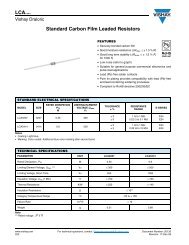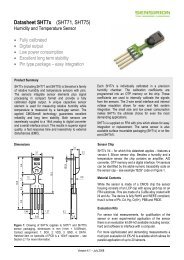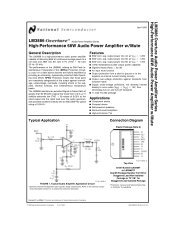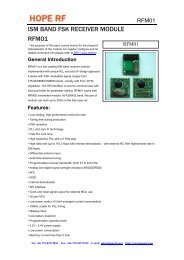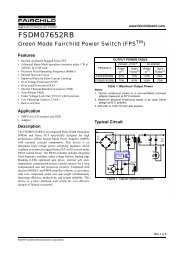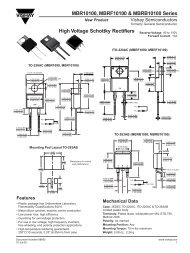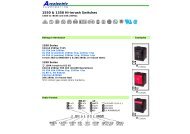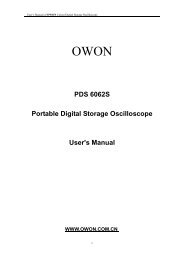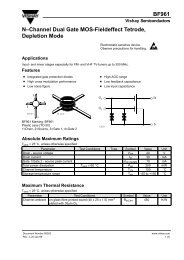Lm2576/lm2576hv series simple switcher 3a step-down voltage ...
Lm2576/lm2576hv series simple switcher 3a step-down voltage ...
Lm2576/lm2576hv series simple switcher 3a step-down voltage ...
Create successful ePaper yourself
Turn your PDF publications into a flip-book with our unique Google optimized e-Paper software.
September 1996<br />
LM2576LM2576HV Series<br />
SIMPLE SWITCHER 3A Step-Down Voltage Regulator<br />
General Description<br />
The LM2576 <strong>series</strong> of regulators are monolithic integrated<br />
circuits that provide all the active functions for a <strong>step</strong>-<strong>down</strong><br />
(buck) switching regulator capable of driving 3A load with<br />
excellent line and load regulation These devices are available<br />
in fixed output <strong>voltage</strong>s of 33V 5V 12V 15V and an<br />
adjustable output version<br />
Requiring a minimum number of external components<br />
these regulators are <strong>simple</strong> to use and include internal frequency<br />
compensation and a fixed-frequency oscillator<br />
The LM2576 <strong>series</strong> offers a high-efficiency replacement for<br />
popular three-terminal linear regulators It substantially reduces<br />
the size of the heat sink and in some cases no heat<br />
sink is required<br />
A standard <strong>series</strong> of inductors optimized for use with the<br />
LM2576 are available from several different manufacturers<br />
This feature greatly simplifies the design of switch-mode<br />
power supplies<br />
Other features include a guaranteed g4% tolerance on output<br />
<strong>voltage</strong> within specified input <strong>voltage</strong>s and output load<br />
conditions and g10% on the oscillator frequency External<br />
shut<strong>down</strong> is included featuring 50 mA (typical) standby current<br />
The output switch includes cycle-by-cycle current limiting<br />
as well as thermal shut<strong>down</strong> for full protection under<br />
fault conditions<br />
Typical Application (Fixed Output Voltage Versions)<br />
Block Diagram<br />
Features<br />
Y<br />
Y<br />
Y<br />
Y<br />
Y<br />
Y<br />
Y<br />
Y<br />
Y<br />
Y<br />
Y<br />
33V 5V 12V 15V and adjustable output versions<br />
Adjustable version output <strong>voltage</strong> range<br />
123V to 37V (57V for HV version) g4% max over<br />
line and load conditions<br />
Guaranteed 3A output current<br />
Wide input <strong>voltage</strong> range 40V up to 60V for<br />
HV version<br />
Requires only 4 external components<br />
52 kHz fixed frequency internal oscillator<br />
TTL shut<strong>down</strong> capability low power standby mode<br />
High efficiency<br />
Uses readily available standard inductors<br />
Thermal shut<strong>down</strong> and current limit protection<br />
Pa Product Enhancement tested<br />
Applications<br />
Y<br />
Y<br />
Y<br />
Y<br />
FIGURE 1<br />
Simple high-efficiency <strong>step</strong>-<strong>down</strong> (buck) regulator<br />
Efficient pre-regulator for linear regulators<br />
On-card switching regulators<br />
Positive to negative converter (Buck-Boost)<br />
TLH11476–1<br />
LM2576LM2576HV Series SIMPLE SWITCHER 3A Step-Down Voltage Regulator<br />
33V R2 e 17k<br />
5V R2 e 31k<br />
12V R2 e 884k<br />
15V R2 e 113k<br />
For ADJ Version<br />
R1 e Open R2 e 0X<br />
TLH11476–2<br />
Patent Pending<br />
SIMPLE SWITCHER is a registered trademark of National Semiconductor Corporation<br />
C1996 National Semiconductor Corporation TLH11476<br />
RRD-B30M106Printed in U S A httpwwwnationalcom
Absolute Maximum Ratings (Note 1)<br />
If MilitaryAerospace specified devices are required<br />
please contact the National Semiconductor Sales<br />
OfficeDistributors for availability and specifications<br />
Maximum Supply Voltage<br />
LM2576<br />
LM2576HV<br />
ONOFF Pin Input Voltage<br />
Output Voltage to Ground<br />
(Steady State)<br />
Power Dissipation<br />
Storage Temperature Range<br />
45V<br />
63V<br />
b03V s V s aV IN<br />
b1V<br />
Internally Limited<br />
b65Ctoa150C<br />
Minimum ESD Rating<br />
(C e 100 pF R e 15 kX) 2kV<br />
Lead Temperature<br />
(Soldering 10 Seconds)<br />
260C<br />
Maximum Junction Temperature<br />
150C<br />
Operating Ratings<br />
Temperature Range<br />
LM2576LM2576HV<br />
Supply Voltage<br />
LM2576<br />
LM2576HV<br />
b40C s T J<br />
s a125C<br />
LM2576-33 LM2576HV-33<br />
Electrical Characteristics Specifications with standard type face are for T J e 25C and those with boldface<br />
type apply over full Operating Temperature Range<br />
Symbol Parameter Conditions<br />
SYSTEM PARAMETERS (Note 3) Test Circuit Figure 2<br />
Typ<br />
LM2576-33<br />
LM2576HV-33<br />
Limit<br />
(Note 2)<br />
40V<br />
60V<br />
Units<br />
(Limits)<br />
V OUT Output Voltage V IN e 12V I LOAD e 05A 33 V<br />
Circuit of Figure 2 3234 V(Min)<br />
3366<br />
V(Max)<br />
V OUT Output Voltage 6V s V IN<br />
s 40V 05A s I LOAD<br />
s 3A 33 V<br />
LM2576 Circuit of Figure 2 31683135 V(Min)<br />
34323465 V(Max)<br />
V OUT Output Voltage 6V s V IN<br />
s 60V 05A s I LOAD<br />
s 3A 33 V<br />
LM2576HV Circuit of Figure 2 31683135 V(Min)<br />
34503482 V(Max)<br />
h Efficiency V IN e 12V I LOAD e 3A 75 %<br />
LM2576-50 LM2576HV-50<br />
Electrical Characteristics Specifications with standard type face are for T J e 25C and those with boldface<br />
type apply over full Operating Temperature Range<br />
Symbol Parameter Conditions<br />
SYSTEM PARAMETERS (Note 3) Test Circuit Figure 2<br />
Typ<br />
LM2576-50<br />
LM2576HV-50<br />
Limit<br />
(Note 2)<br />
Units<br />
(Limits)<br />
V OUT Output Voltage V IN e 12V I LOAD e 05A 50 V<br />
Circuit of Figure 2 4900 V(Min)<br />
5100<br />
V(Max)<br />
V OUT Output Voltage 05A s I LOAD<br />
s 3A 50 V<br />
LM2576 8V s V IN<br />
s 40V 48004750 V(Min)<br />
Circuit of Figure 2 52005250 V(Max)<br />
V OUT Output Voltage 05A s I LOAD<br />
s 3A 50 V<br />
LM2576HV 8V s V IN<br />
s 60V 48004750 V(Min)<br />
Circuit of Figure 2 52255275 V(Max)<br />
h Efficiency V IN e 12V I LOAD e 3A 77 %<br />
httpwwwnationalcom 2
LM2576-12 LM2576HV-12<br />
Electrical Characteristics Specifications with standard type face are for T J e 25C and those with boldface<br />
type apply over full Operating Temperature Range<br />
Symbol Parameter Conditions<br />
SYSTEM PARAMETERS (Note 3) Test Circuit Figure 2<br />
Typ<br />
LM2576-12<br />
LM2576HV-12<br />
Limit<br />
(Note 2)<br />
Units<br />
(Limits)<br />
V OUT Output Voltage V IN e 25V I LOAD e 05A 12 V<br />
Circuit of Figure 2 1176 V(Min)<br />
1224<br />
V(Max)<br />
V OUT Output Voltage 05A s I LOAD<br />
s 3A 12 V<br />
LM2576 15V s V IN<br />
s 40V 11521140 V(Min)<br />
Circuit of Figure 2 12481260 V(Max)<br />
V OUT Output Voltage 05A s I LOAD<br />
s 3A 12 V<br />
LM2576HV 15V s V IN<br />
s 60V 11521140 V(Min)<br />
Circuit of Figure 2 12541266 V(Max)<br />
h Efficiency V IN e 15V I LOAD e 3A 88 %<br />
LM2576-15 LM2576HV-15<br />
Electrical Characteristics Specifications with standard type face are for T J e 25C and those with boldface<br />
type apply over full Operating Temperature Range<br />
Symbol Parameter Conditions<br />
SYSTEM PARAMETERS (Note 3) Test Circuit Figure 2<br />
Typ<br />
LM2576-15<br />
LM2576HV-15<br />
Limit<br />
(Note 2)<br />
Units<br />
(Limits)<br />
V OUT Output Voltage V IN e 25V I LOAD e 05A 15 V<br />
Circuit of Figure 2 1470 V(Min)<br />
1530<br />
V(Max)<br />
V OUT Output Voltage 05A s I LOAD<br />
s 3A 15 V<br />
LM2576 18V s V IN<br />
s 40V 14401425 V(Min)<br />
Circuit of Figure 2 15601575 V(Max)<br />
V OUT Output Voltage 05A s I LOAD<br />
s 3A 15 V<br />
LM2576HV 18V s V IN<br />
s 60V 14401425 V(Min)<br />
Circuit of Figure 2 15681583 V(Max)<br />
h Efficiency V IN e 18V I LOAD e 3A 88 %<br />
LM2576-ADJ LM2576HV-ADJ<br />
Electrical Characteristics Specifications with standard type face are for T J e 25C and those with boldface<br />
type apply over full Operating Temperature Range<br />
Symbol Parameter Conditions<br />
SYSTEM PARAMETERS (Note 3) Test Circuit Figure 2<br />
Typ<br />
LM2576-ADJ<br />
LM2576HV-ADJ<br />
Limit<br />
(Note 2)<br />
Units<br />
(Limits)<br />
V OUT Feedback Voltage V IN e 12V I LOAD e 05A 1230 V<br />
V OUT e 5V 1217 V(Min)<br />
Circuit of Figure 2 1243 V(Max)<br />
V OUT Feedback Voltage 05A s I LOAD<br />
s 3A 1230 V<br />
LM2576 8V s V IN<br />
s 40V 11931180 V(Min)<br />
V OUT e 5V Circuit of Figure 2 12671280 V(Max)<br />
V OUT Feedback Voltage 05A s I LOAD<br />
s 3A 1230 V<br />
LM2576HV 8V s V IN<br />
s 60V 11931180 V(Min)<br />
V OUT e 5V Circuit of Figure 2 12731286 V(Max)<br />
h Efficiency V IN e 12V I LOAD e 3A V OUT e 5V 77 %<br />
3<br />
httpwwwnationalcom
All Output Voltage Versions<br />
Electrical Characteristics Specifications with standard type face are for T J e 25C and those with boldface<br />
type apply over full Operating Temperature Range Unless otherwise specified V IN e 12V for the 33V 5V and Adjustable<br />
version V IN e 25V for the 12V version and V IN e 30V for the 15V version I LOAD e 500 mA<br />
Symbol Parameter Conditions<br />
Typ<br />
LM2576-XX<br />
LM2576HV-XX<br />
Limit<br />
(Note 2)<br />
DEVICE PARAMETERS<br />
I b Feedback Bias Current V OUT e 5V (Adjustable Version Only) 50 100500 nA<br />
Units<br />
(Limits)<br />
f O Oscillator Frequency (Note 11) 52 kHz<br />
4742 kHz (Min)<br />
5863 kHz (Max)<br />
V SAT Saturation Voltage I OUT e 3A (Note 4) 14 V<br />
1820 V(Max)<br />
DC Max Duty Cycle (ON) (Note 5) 98 %<br />
93 %(Min)<br />
I CL Current Limit (Notes 4 and 11) 58 A<br />
4235 A(Min)<br />
6975 A(Max)<br />
I L Output Leakage Current (Notes 6 and 7) Output e 0V 2 mA(Max)<br />
Output eb1V 75 mA<br />
Output eb1V 30 mA(Max)<br />
I Q Quiescent Current (Note 6) 5 mA<br />
10 mA(Max)<br />
I STBY Standby Quiescent ONOFF Pin e 5V (OFF) 50 mA<br />
Current 200 mA(Max)<br />
i JA Thermal Resistance T Package Junction to Ambient (Note 8) 65<br />
i JA T Package Junction to Ambient (Note 9) 45 CW<br />
i JC T Package Junction to Case 2<br />
i JA S Package Junction to Ambient (Note 10) 50<br />
ONOFF CONTROL Test Circuit Figure 2<br />
V IH ONOFF Pin V OUT e 0V 14 2224 V(Min)<br />
V IL<br />
Logic Input Level<br />
V OUT e Nominal Output Voltage 12 1008 V(Max)<br />
I IH ONOFF Pin Input ONOFF Pin e 5V (OFF) 12 mA<br />
Current 30 mA(Max)<br />
I IL ONOFF Pin e 0V (ON) 0 mA<br />
10 mA(Max)<br />
Note 1 Absolute Maximum Ratings indicate limits beyond which damage to the device may occur Operating Ratings indicate conditions for which the device is<br />
intended to be functional but do not guarantee specific performance limits For guaranteed specifications and test conditions see the Electrical Characteristics<br />
Note 2 All limits guaranteed at room temperature (standard type face) and at temperature extremes (bold type face) All room temperature limits are 100%<br />
production tested All limits at temperature extremes are guaranteed via correlation using standard Statistical Quality Control (SQC) methods<br />
Note 3 External components such as the catch diode inductor input and output capacitors can affect switching regulator system performance When the<br />
LM2576LM2576HV is used as shown in the Figure 2 test circuit system performance will be as shown in system parameters section of Electrical Characteristics<br />
Note 4 Output pin sourcing current No diode inductor or capacitor connected to output<br />
Note 5 Feedback pin removed from output and connected to 0V<br />
Note 6 Feedback pin removed from output and connected to a12V for the Adjustable 33V and 5V versions and a25V for the 12V and 15V versions to force<br />
the output transistor OFF<br />
Note 7 V IN e 40V (60V for high <strong>voltage</strong> version)<br />
Note 8 Junction to ambient thermal resistance (no external heat sink) for the 5 lead TO-220 package mounted vertically with inch leads in a socket or on a PC<br />
board with minimum copper area<br />
Note 9 Junction to ambient thermal resistance (no external heat sink) for the 5 lead TO-220 package mounted vertically with inch leads soldered to a PC board<br />
containing approximately 4 square inches of copper area surrounding the leads<br />
Note 10 If the TO-263 package is used the thermal resistance can be reduced by increasing the PC board copper area thermally connected to the package Using<br />
05 square inches of copper area i JA is 50CW with 1 square inch of copper area i JA is 37CW and with 16 or more square inches of copper area i JA is<br />
32CW<br />
Note 11 The oscillator frequency reduces to approximately 11 kHz in the event of an output short or an overload which causes the regulated output <strong>voltage</strong> to drop<br />
approximately 40% from the nominal output <strong>voltage</strong> This self protection feature lowers the average power dissipation of the IC by lowering the minimum duty cycle<br />
from 5% <strong>down</strong> to approximately 2%<br />
httpwwwnationalcom 4
Typical Performance Characteristics (Circuit of Figure 2 )<br />
Normalized Output Voltage Line Regulation Dropout Voltage<br />
Standby<br />
Current Limit Quiescent Current Quiescent Current<br />
Oscillator Frequency<br />
Switch Saturation<br />
Voltage<br />
Efficiency<br />
Minimum Operating Voltage<br />
Quiescent Current<br />
vs Duty Cycle<br />
Feedback Voltage<br />
vs Duty Cycle<br />
TLH11476–3<br />
5<br />
httpwwwnationalcom
Typical Performance Characteristics (Circuit of Figure 2 ) (Continued)<br />
Maximum Power Dissipation<br />
(TO-263) (See Note 10)<br />
TLH11476–24<br />
Feedback Pin Current<br />
Switching Waveforms<br />
Load Transient Response<br />
TLH11476–4<br />
TLH11476–5<br />
V OUT e 15V<br />
A Output Pin Voltage 50Vdiv<br />
B Output Pin Current 2Adiv<br />
C Inductor Current 2Adiv<br />
D Output Ripple Voltage 50 mVdiv<br />
AC-Coupled<br />
Horizontal Time Base 5 msdiv<br />
TLH11476–6<br />
As in any switching regulator layout is very important Rapidly<br />
switching currents associated with wiring inductance<br />
generate <strong>voltage</strong> transients which can cause problems For<br />
minimal inductance and ground loops the length of the<br />
leads indicated by heavy lines should be kept as short as<br />
possible Single-point grounding (as indicated) or ground<br />
plane construction should be used for best results When<br />
using the Adjustable version physically locate the programming<br />
resistors near the regulator to keep the sensitive<br />
feedback wiring short<br />
httpwwwnationalcom 6
Test Circuit and Layout Guidelines<br />
Fixed Output Voltage Versions<br />
C IN 100 mF 75V Aluminum Electrolytic<br />
C OUT 1000 mF 25V Aluminum Electrolytic<br />
D 1 Schottky MBR360<br />
L 1 100 mH Pulse Eng PE-92108<br />
R 1 2k 01%<br />
R 2 612k 01%<br />
TLH11476–7<br />
Adjustable Output Voltage Version<br />
V OUT e V REF<br />
1 a R 2<br />
R 1J<br />
R 2 e R 1<br />
V OUT<br />
b 1<br />
V REF J<br />
where V REF e 123V R1 between 1k and 5k<br />
FIGURE 2<br />
TLH11476–8<br />
7<br />
httpwwwnationalcom
LM2576 Series Buck Regulator Design Procedure<br />
PROCEDURE (Fixed Output Voltage Versions)<br />
EXAMPLE (Fixed Output Voltage Versions)<br />
Given<br />
Given<br />
V OUT e Regulated Output Voltage (33V 5V 12V or 15V) V OUT e 5V<br />
V IN (Max) e Maximum Input Voltage<br />
V IN (Max) e 15V<br />
I LOAD (Max) e Maximum Load Current<br />
I LOAD (Max) e 3A<br />
1 Inductor Selection (L1) 1 Inductor Selection (L1)<br />
A Select the correct Inductor value selection guide from A Use the selection guide shown in Figure 4 <br />
Figures 3 4 5 or 6 (Output <strong>voltage</strong>s of 33V 5V 12V or B From the selection guide the inductance area<br />
15V respectively) For other output <strong>voltage</strong>s see the<br />
intersected by the 15V line and 3A line is L100<br />
design procedure for the adjustable version<br />
C Inductor value required is 100 mH From the table in<br />
B From the inductor value selection guide identify the<br />
Figure 3 Choose AIE 415-0930 Pulse Engineering<br />
inductance region intersected by V IN (Max) and<br />
PE92108 or Renco RL2444<br />
I LOAD (Max) and note the inductor code for that region<br />
C Identify the inductor value from the inductor code and<br />
select an appropriate inductor from the table shown in<br />
Figure 3 Part numbers are listed for three inductor<br />
manufacturers The inductor chosen must be rated for<br />
operation at the LM2576 switching frequency (52 kHz) and<br />
for a current rating of 115 c I LOAD For additional<br />
inductor information see the inductor section in the<br />
Application Hints section of this data sheet<br />
2 Output Capacitor Selection (C OUT ) 2 Output Capacitor Selection (C OUT )<br />
A The value of the output capacitor together with the<br />
A C OUT e 680 mF to 2000 mF standard aluminum<br />
inductor defines the dominate pole-pair of the switching<br />
electrolytic<br />
regulator loop For stable operation and an acceptable<br />
B Capacitor <strong>voltage</strong> rating e 20V<br />
output ripple <strong>voltage</strong> (approximately 1% of the output<br />
<strong>voltage</strong>) a value between 100 mF and 470 mFis<br />
recommended<br />
B The capacitor’s <strong>voltage</strong> rating should be at least 15<br />
times greater than the output <strong>voltage</strong> For a 5V regulator<br />
a rating of at least 8V is appropriate and a 10V or 15V<br />
rating is recommended<br />
Higher <strong>voltage</strong> electrolytic capacitors generally have lower<br />
ESR numbers and for this reason it may be necessary to<br />
select a capacitor rated for a higher <strong>voltage</strong> than would<br />
normally be needed<br />
3 Catch Diode Selection (D1) 3 Catch Diode Selection (D1)<br />
A The catch-diode current rating must be at least 12<br />
A For this example a 3A current rating is adequate<br />
times greater than the maximum load current Also if the B Use a 20V 1N5823 or SR302 Schottky diode or any of<br />
power supply design must withstand a continuous output the suggested fast-recovery diodes shown in Figure 8 <br />
short the diode should have a current rating equal to the<br />
maximum current limit of the LM2576 The most stressful<br />
condition for this diode is an overload or shorted output<br />
condition<br />
B The reverse <strong>voltage</strong> rating of the diode should be at<br />
least 125 times the maximum input <strong>voltage</strong><br />
4 Input Capacitor (C IN ) 4 Input Capacitor (C IN )<br />
An aluminum or tantalum electrolytic bypass capacitor<br />
A 100 mF 25V aluminum electrolytic capacitor located<br />
located close to the regulator is needed for stable<br />
near the input and ground pins provides sufficient<br />
operation<br />
bypassing<br />
httpwwwnationalcom 8
LM2576 Series Buck Regulator Design Procedure (Continued)<br />
INDUCTOR VALUE SELECTION GUIDES (For Continuous Mode Operation)<br />
FIGURE 3 LM2576(HV)-33<br />
TLH11476–9<br />
FIGURE 4 LM2576(HV)-50<br />
TLH11476–10<br />
FIGURE 5 LM2576(HV)-12<br />
TLH11476–11<br />
FIGURE 6 LM2576(HV)-15<br />
TLH11476–12<br />
FIGURE 7 LM2576(HV)-ADJ<br />
TLH11476–13<br />
9<br />
httpwwwnationalcom
LM2576 Series Buck Regulator Design Procedure (Continued)<br />
PROCEDURE (Adjustable Output Voltage Versions)<br />
EXAMPLE (Adjustable Output Voltage Versions)<br />
Given<br />
Given<br />
V OUT e Regulated Output Voltage<br />
V OUT e 10V<br />
V IN (Max) e Maximum Input Voltage<br />
V IN (Max) e 25V<br />
I LOAD (Max) e Maximum Load Current<br />
I LOAD (Max) e 3A<br />
F e Switching Frequency (Fixed at 52 kHz)<br />
F e 52 kHz<br />
1 Programming Output Voltage (Selecting R1 and R2 as 1 Programming Output Voltage (Selecting R1 and R2)<br />
shown in Figure 2)<br />
Use the following formula to select the appropriate V OUT e 123<br />
1 a R 2<br />
Select R1 e 1k<br />
resistor values<br />
R 1J<br />
V OUT e V REF<br />
1 a R 2<br />
R 1J<br />
where V REF e 123V R 2 e R 1<br />
V OUT<br />
b 1<br />
V REF J e 1k 10V<br />
R 1 can be between 1k and 5k (For best temperature<br />
coefficient and stability with time use 1% metal film<br />
resistors)<br />
R 2 e R 1<br />
V OUT<br />
V REF<br />
b 1<br />
J<br />
123V b 1 J<br />
R 2 e 1k (813 b 1) e 713k closest 1% value is 715k<br />
2 Inductor Selection (L1) 2 Inductor Selection (L1)<br />
A Calculate the inductor Volt microsecond constant<br />
A Calculate E T(Vms)<br />
E T(Vms) from the following formula<br />
E T e (25 b 10) 10<br />
25 1000 e 115 V ms<br />
E T e (V IN b V OUT ) V OUT 1000<br />
(V ms)<br />
52<br />
V IN F (in kHz)<br />
B E T e 115 V ms<br />
B Use the E T value from the previous formula and<br />
C I LOAD (Max) e<br />
match it with the E T number on the vertical axis of the<br />
3A<br />
Inductor Value Selection Guide shown in Figure 7<br />
D Inductance Region e H150<br />
C On the horizontal axis select the maximum load<br />
E Inductor Value e 150 mH Choose from AIE<br />
current<br />
part 415-0936 Pulse Engineering<br />
D Identify the inductance region intersected by the E T part PE-531115 or Renco part RL2445<br />
value and the maximum load current value and note the<br />
inductor code for that region<br />
E Identify the inductor value from the inductor code and<br />
select an appropriate inductor from the table shown in<br />
Figure 9 Part numbers are listed for three inductor<br />
manufacturers The inductor chosen must be rated for<br />
operation at the LM2576 switching frequency (52 kHz)<br />
and for a current rating of 115 c I LOAD For additional<br />
inductor information see the inductor section in the<br />
application hints section of this data sheet<br />
3 Output Capacitor Selection (C OUT ) 3 Output Capacitor Selection (C OUT )<br />
25<br />
A The value of the output capacitor together with the<br />
A C OUT<br />
l 13300 e 222 mF<br />
inductor defines the dominate pole-pair of the switching<br />
10 150<br />
regulator loop For stable operation the capacitor must<br />
However for acceptable output ripple <strong>voltage</strong> select<br />
satisfy the following requirement<br />
C OUT<br />
t 680 mF<br />
V<br />
C OUT<br />
t IN (Max)<br />
13300<br />
V OUT L(mH) (mF)<br />
C OUT e 680 mF electrolytic capacitor<br />
The above formula yields capacitor values between 10 mF<br />
and 2200 mF that will satisfy the loop requirements for<br />
stable operation But to achieve an acceptable output<br />
ripple <strong>voltage</strong> (approximately 1% of the output <strong>voltage</strong>)<br />
and transient response the output capacitor may need to<br />
be several times larger than the above formula yields<br />
B The capacitor’s <strong>voltage</strong> rating should be at last 15<br />
times greater than the output <strong>voltage</strong> For a 10V regulator<br />
a rating of at least 15V or more is recommended<br />
Higher <strong>voltage</strong> electrolytic capacitors generally have<br />
lower ESR numbers and for this reason it may be<br />
necessary to select a capacitor rate for a higher <strong>voltage</strong><br />
than would normally be needed<br />
httpwwwnationalcom 10
LM2576 Series Buck Regulator Design Procedure (Continued)<br />
PROCEDURE (Adjustable Output Voltage Versions)<br />
EXAMPLE (Adjustable Output Voltage Versions)<br />
4 Catch Diode Selection (D1) 4 Catch Diode Selection (D1)<br />
A The catch-diode current rating must be at least 12 A For this example a 33A current rating is adequate<br />
times greater than the maximum load current Also if the B Use a 30V 31DQ03 Schottky diode or any of the suggested<br />
power supply design must withstand a continuous output<br />
short the diode should have a current rating equal to the<br />
maximum current limit of the LM2576 The most stressful<br />
condition for this diode is an overload or shorted output<br />
See diode selection guide in Figure 8 <br />
B The reverse <strong>voltage</strong> rating of the diode should be at<br />
least 125 times the maximum input <strong>voltage</strong><br />
fast-recovery diodes in Figure 8<br />
5 Input Capacitor (C IN ) 5 Input Capacitor (C IN )<br />
An aluminum or tantalum electrolytic bypass capacitor A 100 mF aluminum electrolytic capacitor located near the input<br />
located close to the regulator is needed for stable<br />
and ground pins provides sufficient bypassing<br />
operation<br />
Schottky Fast Recovery<br />
V R<br />
3A 4A–6A 3A 4A–6A<br />
20V 1N5820 1N5823<br />
MBR320P<br />
SR302<br />
30V 1N5821 50WQ03<br />
MBR330 1N5824<br />
31DQ03<br />
The following<br />
SR303<br />
The following<br />
diodes are all<br />
diodes are all<br />
40V 1N5822 MBR340<br />
rated to 100V<br />
rated to 100V<br />
MBR340 50WQ04<br />
31DQ04 1N5825<br />
50WF10<br />
31DF1<br />
SR304<br />
MUR410<br />
HER302<br />
50V MBR350 50WQ05<br />
HER602<br />
31DQ05<br />
SR305<br />
60V MBR360 50WR06<br />
DQ06 50SQ060<br />
SR306<br />
FIGURE 8 Diode Selection Guide<br />
To further simplify the buck regulator<br />
design procedure National Semiconductor<br />
is making available computer<br />
design software to be used with the<br />
SIMPLE SWITCHER line of switching<br />
regulators Switchers Made Simple<br />
(Version 33) is available on a (3)<br />
diskette for IBM compatible computers<br />
from a National Semiconductor sales<br />
office in your area<br />
Inductor Inductor Schott Pulse Eng Renco<br />
Code Value (Note 1) (Note 2) (Note 3)<br />
L47 47 mH 671 26980 PE-53112 RL2442<br />
L68 68 mH 671 26990 PE-92114 RL2443<br />
L100 100 mH 671 27000 PE-92108 RL2444<br />
L150 150 mH 671 27010 PE-53113 RL1954<br />
L220 220 mH 671 27020 PE-52626 RL1953<br />
L330 330 mH 671 27030 PE-52627 RL1952<br />
L470 470 mH 671 27040 PE-53114 RL1951<br />
L680 680 mH 671 27050 PE-52629 RL1950<br />
H150 150 mH 671 27060 PE-53115 RL2445<br />
H220 220 mH 671 27070 PE-53116 RL2446<br />
H330 330 mH 671 27080 PE-53117 RL2447<br />
H470 470 mH 671 27090 PE-53118 RL1961<br />
H680 680 mH 671 27100 PE-53119 RL1960<br />
H1000 1000 mH 671 27110 PE-53120 RL1959<br />
H1500 1500 mH 671 27120 PE-53121 RL1958<br />
H2200 2200 mH 671 27130 PE-53122 RL2448<br />
Note 1 Schott Corporation (612) 475-1173 1000 Parkers Lake Road Wayzata MN 55391<br />
Note 2 Pulse Engineering (619) 674-8100 PO Box 12235 San Diego CA 92112<br />
Note 3 Renco Electronics Incorporated (516) 586-5566 60 Jeffryn Blvd East Deer Park NY 11729<br />
FIGURE 9 Inductor Selection by Manufacturer’s Part Number<br />
11<br />
httpwwwnationalcom
Application Hints<br />
INPUT CAPACITOR (C IN )<br />
To maintain stability the regulator input pin must be bypassed<br />
with at least a 100 mF electrolytic capacitor The<br />
capacitor’s leads must be kept short and located near the<br />
regulator<br />
If the operating temperature range includes temperatures<br />
below b25C the input capacitor value may need to be<br />
larger With most electrolytic capacitors the capacitance<br />
value decreases and the ESR increases with lower temperatures<br />
and age Paralleling a ceramic or solid tantalum capacitor<br />
will increase the regulator stability at cold temperatures<br />
For maximum capacitor operating lifetime the capacitor’s<br />
RMS ripple current rating should be greater than<br />
12 c<br />
t ON<br />
T J c I LOAD<br />
where t ON<br />
T<br />
e V OUT<br />
for a buck regulator<br />
V IN<br />
and t ON l<br />
T e V OUTl<br />
lV OUTl a V for a buck-boost regulator<br />
IN<br />
INDUCTOR SELECTION<br />
All switching regulators have two basic modes of operation<br />
continuous and discontinuous The difference between the<br />
two types relates to the inductor current whether it is flowing<br />
continuously or if it drops to zero for a period of time in<br />
the normal switching cycle Each mode has distinctively different<br />
operating characteristics which can affect the regulator<br />
performance and requirements<br />
The LM2576 (or any of the SIMPLE SWITCHER family) can<br />
be used for both continuous and discontinuous modes of<br />
operation<br />
The inductor value selection guides in Figure 3 through Figure<br />
7 were designed for buck regulator designs of the continuous<br />
inductor current type When using inductor values<br />
shown in the inductor selection guide the peak-to-peak inductor<br />
ripple current will be approximately 20% to 30% of<br />
the maximum DC current With relatively heavy load currents<br />
the circuit operates in the continuous mode (inductor<br />
current always flowing) but under light load conditions the<br />
circuit will be forced to the discontinuous mode (inductor<br />
current falls to zero for a period of time) This discontinuous<br />
mode of operation is perfectly acceptable For light loads<br />
(less than approximately 300 mA) it may be desirable to<br />
operate the regulator in the discontinuous mode primarily<br />
because of the lower inductor values required for the discontinuous<br />
mode<br />
The selection guide chooses inductor values suitable for<br />
continuous mode operation but if the inductor value chosen<br />
is prohibitively high the designer should investigate the possibility<br />
of discontinuous operation The computer design<br />
software Switchers Made Simple will provide all component<br />
values for discontinuous (as well as continuous) mode<br />
of operation<br />
Inductors are available in different styles such as pot core<br />
toriod E-frame bobbin core etc as well as different core<br />
materials such as ferrites and powdered iron The least expensive<br />
the bobbin core type consists of wire wrapped on<br />
a ferrite rod core This type of construction makes for an<br />
inexpensive inductor but since the magnetic flux is not completely<br />
contained within the core it generates more electromagnetic<br />
interference (EMI) This EMI can cause problems<br />
in sensitive circuits or can give incorrect scope readings<br />
because of induced <strong>voltage</strong>s in the scope probe<br />
The inductors listed in the selection chart include ferrite pot<br />
core construction for AIE powdered iron toroid for Pulse<br />
Engineering and ferrite bobbin core for Renco<br />
An inductor should not be operated beyond its maximum<br />
rated current because it may saturate When an inductor<br />
begins to saturate the inductance decreases rapidly and<br />
the inductor begins to look mainly resistive (the DC resistance<br />
of the winding) This will cause the switch current to<br />
rise very rapidly Different inductor types have different saturation<br />
characteristics and this should be kept in mind when<br />
selecting an inductor<br />
The inductor manufacturer’s data sheets include current<br />
and energy limits to avoid inductor saturation<br />
INDUCTOR RIPPLE CURRENT<br />
When the <strong>switcher</strong> is operating in the continuous mode the<br />
inductor current waveform ranges from a triangular to a<br />
sawtooth type of waveform (depending on the input <strong>voltage</strong>)<br />
For a given input <strong>voltage</strong> and output <strong>voltage</strong> the peakto-peak<br />
amplitude of this inductor current waveform remains<br />
constant As the load current rises or falls the entire sawtooth<br />
current waveform also rises or falls The average DC<br />
value of this waveform is equal to the DC load current (in<br />
the buck regulator configuration)<br />
If the load current drops to a low enough level the bottom<br />
of the sawtooth current waveform will reach zero and the<br />
<strong>switcher</strong> will change to a discontinuous mode of operation<br />
This is a perfectly acceptable mode of operation Any buck<br />
switching regulator (no matter how large the inductor value<br />
is) will be forced to run discontinuous if the load current is<br />
light enough<br />
OUTPUT CAPACITOR<br />
An output capacitor is required to filter the output <strong>voltage</strong><br />
and is needed for loop stability The capacitor should be<br />
located near the LM2576 using short pc board traces Standard<br />
aluminum electrolytics are usually adequate but low<br />
ESR types are recommended for low output ripple <strong>voltage</strong><br />
and good stability The ESR of a capacitor depends on<br />
many factors some which are the value the <strong>voltage</strong> rating<br />
physical size and the type of construction In general low<br />
value or low <strong>voltage</strong> (less than 12V) electrolytic capacitors<br />
usually have higher ESR numbers<br />
The amount of output ripple <strong>voltage</strong> is primarily a function of<br />
the ESR (Equivalent Series Resistance) of the output capacitor<br />
and the amplitude of the inductor ripple current<br />
(DI IND ) See the section on inductor ripple current in Application<br />
Hints<br />
The lower capacitor values (220 mF–1000 mF) will allow<br />
typically 50 mV to 150 mV of output ripple <strong>voltage</strong> while<br />
larger-value capacitors will reduce the ripple to approximately<br />
20 mV to 50 mV<br />
Output Ripple Voltage e (DI IND ) (ESR of C OUT )<br />
httpwwwnationalcom 12
Application Hints (Continued)<br />
To further reduce the output ripple <strong>voltage</strong> several standard<br />
electrolytic capacitors may be paralleled or a higher-grade<br />
capacitor may be used Such capacitors are often called<br />
‘‘high-frequency’’ ‘‘low-inductance’’ or ‘‘low-ESR’’ These<br />
will reduce the output ripple to 10 mV or 20 mV However<br />
when operating in the continuous mode reducing the ESR<br />
below 003X can cause instability in the regulator<br />
Tantalum capacitors can have a very low ESR and should<br />
be carefully evaluated if it is the only output capacitor Because<br />
of their good low temperature characteristics a tantalum<br />
can be used in parallel with aluminum electrolytics with<br />
the tantalum making up 10% or 20% of the total capacitance<br />
The capacitor’s ripple current rating at 52 kHz should be at<br />
least 50% higher than the peak-to-peak inductor ripple current<br />
CATCH DIODE<br />
Buck regulators require a diode to provide a return path for<br />
the inductor current when the switch is off This diode<br />
should be located close to the LM2576 using short leads<br />
and short printed circuit traces<br />
Because of their fast switching speed and low forward <strong>voltage</strong><br />
drop Schottky diodes provide the best efficiency especially<br />
in low output <strong>voltage</strong> switching regulators (less than<br />
5V) Fast-Recovery High-Efficiency or Ultra-Fast Recovery<br />
diodes are also suitable but some types with an abrupt turnoff<br />
characteristic may cause instability and EMI problems A<br />
fast-recovery diode with soft recovery characteristics is a<br />
better choice Standard 60 Hz diodes (eg 1N4001 or<br />
1N5400 etc) are also not suitable See Figure 8 for<br />
Schottky and ‘‘soft’’ fast-recovery diode selection guide<br />
OUTPUT VOLTAGE RIPPLE AND TRANSIENTS<br />
The output <strong>voltage</strong> of a switching power supply will contain<br />
a sawtooth ripple <strong>voltage</strong> at the <strong>switcher</strong> frequency typically<br />
about 1% of the output <strong>voltage</strong> and may also contain short<br />
<strong>voltage</strong> spikes at the peaks of the sawtooth waveform<br />
The output ripple <strong>voltage</strong> is due mainly to the inductor sawtooth<br />
ripple current multiplied by the ESR of the output capacitor<br />
(See the inductor selection in the application hints)<br />
The <strong>voltage</strong> spikes are present because of the the fast<br />
switching action of the output switch and the parasitic inductance<br />
of the output filter capacitor To minimize these<br />
<strong>voltage</strong> spikes special low inductance capacitors can be<br />
used and their lead lengths must be kept short Wiring inductance<br />
stray capacitance as well as the scope probe<br />
used to evaluate these transients all contribute to the amplitude<br />
of these spikes<br />
An additional small LC filter (20 mH 100 mF) can be added<br />
to the output (as shown in Figure 15 ) to further reduce the<br />
amount of output ripple and transients A 10 c reduction in<br />
output ripple <strong>voltage</strong> and transients is possible with this filter<br />
FEEDBACK CONNECTION<br />
The LM2576 (fixed <strong>voltage</strong> versions) feedback pin must be<br />
wired to the output <strong>voltage</strong> point of the switching power<br />
supply When using the adjustable version physically locate<br />
both output <strong>voltage</strong> programming resistors near the LM2576<br />
to avoid picking up unwanted noise Avoid using resistors<br />
greater than 100 kX because of the increased chance of<br />
noise pickup<br />
ONOFF INPUT<br />
For normal operation the ONOFF pin should be grounded<br />
or driven with a low-level TTL <strong>voltage</strong> (typically below 16V)<br />
To put the regulator into standby mode drive this pin with a<br />
high-level TTL or CMOS signal The ONOFF pin can be<br />
safely pulled up to aV IN without a resistor in <strong>series</strong> with it<br />
The ONOFF pin should not be left open<br />
GROUNDING<br />
To maintain output <strong>voltage</strong> stability the power ground connections<br />
must be low-impedance (see Figure 2 ) For the<br />
5-lead TO-220 and TO-263 style package both the tab and<br />
pin 3 are ground and either connection may be used as<br />
they are both part of the same copper lead frame<br />
HEAT SINKTHERMAL CONSIDERATIONS<br />
In many cases only a small heat sink is required to keep the<br />
LM2576 junction temperature within the allowed operating<br />
range For each application to determine whether or not a<br />
heat sink will be required the following must be identified<br />
1 Maximum ambient temperature (in the application)<br />
2 Maximum regulator power dissipation (in application)<br />
3 Maximum allowed junction temperature (125C for the<br />
LM2576) For a safe conservative design a temperature<br />
approximately 15C cooler than the maximum temperatures<br />
should be selected<br />
4 LM2576 package thermal resistances i JA and i JC <br />
Total power dissipated by the LM2576 can be estimated as<br />
follows<br />
P D e (V IN )(I Q ) a (V O V IN )(I LOAD )(V SAT )<br />
where I Q (quiescent current) and V SAT can be found in the<br />
Characteristic Curves shown previously V IN is the applied<br />
minimum input <strong>voltage</strong> V O is the regulated output <strong>voltage</strong><br />
and I LOAD is the load current The dynamic losses during<br />
turn-on and turn-off are negligible if a Schottky type catch<br />
diode is used<br />
When no heat sink is used the junction temperature rise<br />
can be determined by the following<br />
DT J e (P D )(i JA )<br />
To arrive at the actual operating junction temperature add<br />
the junction temperature rise to the maximum ambient temperature<br />
T J e DT J a T A<br />
If the actual operating junction temperature is greater than<br />
the selected safe operating junction temperature determined<br />
in <strong>step</strong> 3 then a heat sink is required<br />
When using a heat sink the junction temperature rise can<br />
be determined by the following<br />
DT J e (P D )(i JC a i interface a i Heat sink )<br />
The operating junction temperature will be<br />
T J e T A a DT J<br />
As above if the actual operating junction temperature is<br />
greater than the selected safe operating junction temperature<br />
then a larger heat sink is required (one that has a lower<br />
thermal resistance)<br />
Included on the Switcher Made Simple design software is<br />
a more precise (non-linear) thermal model that can be used<br />
to determine junction temperature with different input-output<br />
parameters or different component values It can also calculate<br />
the heat sink thermal resistance required to maintain<br />
the regulators junction temperature below the maximum operating<br />
temperature<br />
13<br />
httpwwwnationalcom
Additional Applications<br />
INVERTING REGULATOR<br />
Figure 10 shows a LM2576-12 in a buck-boost configuration<br />
to generate a negative 12V output from a positive input <strong>voltage</strong><br />
This circuit bootstraps the regulator’s ground pin to the<br />
negative output <strong>voltage</strong> then by grounding the feedback<br />
pin the regulator senses the inverted output <strong>voltage</strong> and<br />
regulates it to b12V<br />
For an input <strong>voltage</strong> of 12V or more the maximum available<br />
output current in this configuration is approximately 700 mA<br />
At lighter loads the minimum input <strong>voltage</strong> required drops to<br />
approximately 47V<br />
The switch currents in this buck-boost configuration are<br />
higher than in the standard buck-mode design thus lowering<br />
the available output current Also the start-up input current<br />
of the buck-boost converter is higher than the standard<br />
buck-mode regulator and this may overload an input power<br />
source with a current limit less than 5A Using a delayed<br />
turn-on or an under<strong>voltage</strong> lockout circuit (described in the<br />
next section) would allow the input <strong>voltage</strong> to rise to a high<br />
enough level before the <strong>switcher</strong> would be allowed to turn<br />
on<br />
Because of the structural differences between the buck and<br />
the buck-boost regulator topologies the buck regulator design<br />
procedure section can not be used to to select the<br />
inductor or the output capacitor The recommended range<br />
of inductor values for the buck-boost design is between<br />
68 mH and 220 mH and the output capacitor values must be<br />
larger than what is normally required for buck designs Low<br />
input <strong>voltage</strong>s or high output currents require a large value<br />
output capacitor (in the thousands of micro Farads)<br />
The peak inductor current which is the same as the peak<br />
switch current can be calculated from the following formula<br />
I p I LOAD (V IN a lV Ol)<br />
V IN<br />
a V IN lV Ol<br />
V IN alV Ol c 1<br />
2L 1 f osc<br />
Where f osc e 52 kHz Under normal continuous inductor<br />
current operating conditions the minimum V IN represents<br />
the worst case Select an inductor that is rated for the peak<br />
current anticipated<br />
NEGATIVE BOOST REGULATOR<br />
Another variation on the buck-boost topology is the negative<br />
boost configuration The circuit in Figure 11 accepts an<br />
input <strong>voltage</strong> ranging from b5V to b12V and provides a<br />
regulated b12V output Input <strong>voltage</strong>s greater than b12V<br />
will cause the output to rise above b12V but will not damage<br />
the regulator<br />
Note Heat sink may be required<br />
Typical Load Current<br />
400 mA for V IN eb52V<br />
750 mA for V IN eb7V<br />
TLH11476–15<br />
FIGURE 11 Negative Boost<br />
Because of the boosting function of this type of regulator<br />
the switch current is relatively high especially at low input<br />
<strong>voltage</strong>s Output load current limitations are a result of the<br />
maximum current rating of the switch Also boost regulators<br />
can not provide current limiting load protection in the event<br />
of a shorted load so some other means (such as a fuse)<br />
may be necessary<br />
UNDERVOLTAGE LOCKOUT<br />
In some applications it is desirable to keep the regulator off<br />
until the input <strong>voltage</strong> reaches a certain threshold An under<strong>voltage</strong><br />
lockout circuit which accomplishes this task is<br />
shown in Figure 12 while Figure 13 shows the same circuit<br />
applied to a buck-boost configuration These circuits keep<br />
the regulator off until the input <strong>voltage</strong> reaches a predetermined<br />
level<br />
V TH V Z1 a 2V BE (Q1)<br />
TLH11476–14<br />
FIGURE 10 Inverting Buck-Boost Develops b12V<br />
Also the maximum <strong>voltage</strong> appearing across the regulator<br />
is the absolute sum of the input and output <strong>voltage</strong> For a<br />
b12V output the maximum input <strong>voltage</strong> for the LM2576 is<br />
a28V or a48V for the LM2576HV<br />
The Switchers Made Simple (version 30) design software<br />
can be used to determine the feasibility of regulator designs<br />
using different topologies different input-output parameters<br />
different components etc<br />
Note Complete circuit not shown<br />
TLH11476–16<br />
FIGURE 12 Under<strong>voltage</strong> Lockout for Buck Circuit<br />
httpwwwnationalcom 14
Additional Applications (Continued)<br />
ADJUSTABLE OUTPUT LOW-RIPPLE<br />
POWER SUPPLY<br />
A 3A power supply that features an adjustable output <strong>voltage</strong><br />
is shown in Figure 15 An additional L-C filter that reduces<br />
the output ripple by a factor of 10 or more is included in<br />
this circuit<br />
Note Complete circuit not shown (see Figure 10)<br />
TLH11476–17<br />
FIGURE 13 Under<strong>voltage</strong> Lockout<br />
for Buck-Boost Circuit<br />
DELAYED STARTUP<br />
The ONOFF pin can be used to provide a delayed startup<br />
feature as shown in Figure 14 With an input <strong>voltage</strong> of 20V<br />
and for the part values shown the circuit provides approximately<br />
10 ms of delay time before the circuit begins switching<br />
Increasing the RC time constant can provide longer delay<br />
times But excessively large RC time constants can<br />
cause problems with input <strong>voltage</strong>s that are high in 60 Hz or<br />
120 Hz ripple by coupling the ripple into the ONOFF pin<br />
Note Complete circuit not shown<br />
FIGURE 14 Delayed Startup<br />
TLH11476–18<br />
TLH11476–19<br />
FIGURE 15 12V to 55V Adjustable 3A Power Supply with Low Output Ripple<br />
15<br />
httpwwwnationalcom
Definition of Terms<br />
BUCK REGULATOR<br />
A switching regulator topology in which a higher <strong>voltage</strong> is<br />
converted to a lower <strong>voltage</strong> Also known as a <strong>step</strong>-<strong>down</strong><br />
switching regulator<br />
BUCK-BOOST REGULATOR<br />
A switching regulator topology in which a positive <strong>voltage</strong> is<br />
converted to a negative <strong>voltage</strong> without a transformer<br />
DUTY CYCLE (D)<br />
Ratio of the output switch’s on-time to the oscillator period<br />
for buck regulator<br />
for buck-boost regulator<br />
D e t ON<br />
T<br />
e V OUT<br />
V IN<br />
D e t ON<br />
T e l V Ol<br />
lV Ol a V IN<br />
CATCH DIODE OR CURRENT STEERING DIODE<br />
The diode which provides a return path for the load current<br />
when the LM2576 switch is OFF<br />
EFFICIENCY (h)<br />
The proportion of input power actually delivered to the load<br />
h e P OUT P<br />
e OUT<br />
P IN P OUT a P LOSS<br />
CAPACITOR EQUIVALENT SERIES RESISTANCE (ESR)<br />
The purely resistive component of a real capacitor’s impedance<br />
(see Figure 16 ) It causes power loss resulting in capacitor<br />
heating which directly affects the capacitor’s operating<br />
lifetime When used as a switching regulator output<br />
filter higher ESR values result in higher output ripple <strong>voltage</strong>s<br />
TLH11476–20<br />
FIGURE 16 Simple Model of a Real Capacitor<br />
Most standard aluminum electrolytic capacitors in the<br />
100 mF–1000 mF range have 05X to 01X ESR Highergrade<br />
capacitors (‘‘low-ESR’’ ‘‘high-frequency’’ or ‘‘low-inductance’’’)<br />
in the 100 mF–1000 mF range generally have<br />
ESR of less than 015X<br />
EQUIVALENT SERIES INDUCTANCE (ESL)<br />
The pure inductance component of a capacitor (see Figure<br />
16 ) The amount of inductance is determined to a large<br />
extent on the capacitor’s construction In a buck regulator<br />
this unwanted inductance causes <strong>voltage</strong> spikes to appear<br />
on the output<br />
OUTPUT RIPPLE VOLTAGE<br />
The AC component of the switching regulator’s output <strong>voltage</strong><br />
It is usually dominated by the output capacitor’s ESR<br />
multiplied by the inductor’s ripple current (DI IND ) The peakto-peak<br />
value of this sawtooth ripple current can be determined<br />
by reading the Inductor Ripple Current section of the<br />
Application hints<br />
CAPACITOR RIPPLE CURRENT<br />
RMS value of the maximum allowable alternating current at<br />
which a capacitor can be operated continuously at a specified<br />
temperature<br />
STANDBY QUIESCENT CURRENT (I STBY )<br />
Supply current required by the LM2576 when in the standby<br />
mode (ONOFF pin is driven to TTL-high <strong>voltage</strong> thus turning<br />
the output switch OFF)<br />
INDUCTOR RIPPLE CURRENT (DI IND )<br />
The peak-to-peak value of the inductor current waveform<br />
typically a sawtooth waveform when the regulator is operating<br />
in the continuous mode (vs discontinuous mode)<br />
CONTINUOUSDISCONTINUOUS MODE OPERATION<br />
Relates to the inductor current In the continuous mode the<br />
inductor current is always flowing and never drops to zero<br />
vs the discontinuous mode where the inductor current<br />
drops to zero for a period of time in the normal switching<br />
cycle<br />
INDUCTOR SATURATION<br />
The condition which exists when an inductor cannot hold<br />
any more magnetic flux When an inductor saturates the<br />
inductor appears less inductive and the resistive component<br />
dominates Inductor current is then limited only by the DC<br />
resistance of the wire and the available source current<br />
OPERATING VOLT MICROSECOND CONSTANT (ET op )<br />
The product (in VoItms) of the <strong>voltage</strong> applied to the inductor<br />
and the time the <strong>voltage</strong> is applied This ET op constant<br />
is a measure of the energy handling capability of an inductor<br />
and is dependent upon the type of core the core area the<br />
number of turns and the duty cycle<br />
httpwwwnationalcom 16
Connection Diagrams<br />
(XX indicates output <strong>voltage</strong> option See ordering information table for complete part number)<br />
Straight Leads<br />
5-Lead TO-220 (T)<br />
Top View<br />
Bent Staggered Leads<br />
5-Lead TO-220 (T)<br />
Top View<br />
LM2576T-XX or LM2576HVT-XX<br />
NS Package Number T05A<br />
TO-263 (S)<br />
5-Lead Surface-Mount Package<br />
Top View<br />
TLH11476–21<br />
Side View<br />
TLH11476–22<br />
LM2576T-XX Flow LB03<br />
or LM2576HVT-XX Flow LB03<br />
NS Package Number T05D<br />
TLH11476–23<br />
Side View<br />
TLH11476–25<br />
TLH11476–26<br />
LM2576S-XX or LM2576HVS-XX<br />
NS Package Number TS5B<br />
LM2576SX-XX or LM2576HVSX-XX<br />
NS Package Number TS5B Tape and Reel<br />
Ordering Information<br />
Temperature<br />
Range<br />
b40C s T A<br />
s 125C<br />
Output Voltage<br />
NS Package Package<br />
33 50 12 15 ADJ Number Type<br />
LM2576HVS-33 LM2576HVS-50 LM2576HVS-12 LM2576HVS-15 LM2576HVS-ADJ<br />
LM2576S-33 LM2576S-50 LM2576S-12 LM2576S-15 LM2576S-ADJ<br />
LM2576HVSX-33 LM2576HVSX-50 LM2576HVSX-12 LM2576HVSX-15 LM2576HVSX-ADJ<br />
LM2576SX-33 LM2576SX-50 LM2576SX-12 LM2576SX-15 LM2576SX-ADJ<br />
LM2576HVT-33 LM2576HVT-50 LM2576HVT-12 LM2576HVT-15 LM2576HVT-ADJ<br />
LM2576T-33 LM2576T-50 LM2576T-12 LM2576T-15 LM2576T-ADJ<br />
LM2576HVT-33 LM2576HVT-50 LM2576HVT-12 LM2576HVT-15 LM2576HVT-ADJ<br />
Flow LB03 Flow LB03 Flow LB03 Flow LB03 Flow LB03<br />
LM2576T-33 LM2576T-50 LM2576T-12 LM2576T-15 LM2576T-ADJ<br />
Flow LB03 Flow LB03 Flow LB03 Flow LB03 Flow LB03<br />
TS5B<br />
TS5B<br />
Tape Reel<br />
T05A<br />
T05D<br />
TO-263<br />
TO-220<br />
17<br />
httpwwwnationalcom
Physical Dimensions inches (millimeters) unless otherwise noted<br />
5-Lead TO-220 (T)<br />
Order Number LM2576T-33 LM2576HVT-33<br />
LM2576T-50 LM2576HVT-50 LM2576T-12<br />
LM2576HVT-12 LM2576T-15 LM2576HVT-15<br />
LM2576T-ADJ or LM2576HVT-ADJ<br />
NS Package Number T05A<br />
httpwwwnationalcom 18
Physical Dimensions inches (millimeters) unless otherwise noted (Continued)<br />
Bent Staggered 5-Lead TO-220 (T)<br />
Order Number LM2576T-33 Flow LB03 LM2576T-XX Flow LB03 LM2576HVT-33 Flow LB03<br />
LM2576T-50 Flow LB03 LM2576HVT-50 Flow LB03<br />
LM2576T-12 Flow LB03 LM2576HVT-12 Flow LB03<br />
LM2576T-15 Flow LB03 LM2576HVT-15 Flow LB03<br />
LM2576T-ADJ Flow LB03 or LM2576HVT-ADJ Flow LB03<br />
NS Package Number T05D<br />
19<br />
httpwwwnationalcom
LM2576LM2576HV Series SIMPLE SWITCHER 3A Step-Down Voltage Regulator<br />
Physical Dimensions inches (millimeters) unless otherwise noted (Continued)<br />
LIFE SUPPORT POLICY<br />
5-Lead TO-263 (S)<br />
Order Number LM2576S-33 LM2576S-50<br />
LM2576S-12LM2576S-15 LM2576S-ADJ<br />
LM2576HVS-33 LM2576HVS-50 LM2576HVS-12<br />
LM2576HVS-15 or LM2576HVS-ADJ<br />
NS Package Number TS5B<br />
5-Lead TO-263 in Tape Reel (SX)<br />
Order Number LM2576SX-33 LM2576SX-50<br />
LM2576SX-12 LM2576SX-15 LM2576SX-ADJ<br />
LM2576HVSX-33 LM2576HVSX-50 LM2576HVSX-12<br />
LM2576HVSX-15 or LM2576HVSX-ADJ<br />
NS Package Number TS5B<br />
NATIONAL’S PRODUCTS ARE NOT AUTHORIZED FOR USE AS CRITICAL COMPONENTS IN LIFE SUPPORT<br />
DEVICES OR SYSTEMS WITHOUT THE EXPRESS WRITTEN APPROVAL OF THE PRESIDENT OF NATIONAL<br />
SEMICONDUCTOR CORPORATION As used herein<br />
1 Life support devices or systems are devices or 2 A critical component is any component of a life<br />
systems which (a) are intended for surgical implant support device or system whose failure to perform can<br />
into the body or (b) support or sustain life and whose be reasonably expected to cause the failure of the life<br />
failure to perform when properly used in accordance support device or system or to affect its safety or<br />
with instructions for use provided in the labeling can effectiveness<br />
be reasonably expected to result in a significant injury<br />
to the user<br />
National Semiconductor National Semiconductor National Semiconductor National Semiconductor<br />
Corporation Europe Hong Kong Ltd Japan Ltd<br />
1111 West Bardin Road Fax a49 (0) 180-530 85 86 13th Floor Straight Block Tel 81-043-299-2308<br />
Arlington TX 76017 Email europesupport nsccom Ocean Centre 5 Canton Rd Fax 81-043-299-2408<br />
Tel 1(800) 272-9959 Deutsch Tel a49 (0) 180-530 85 85 Tsimshatsui Kowloon<br />
Fax 1(800) 737-7018 English Tel a49 (0) 180-532 78 32 Hong Kong<br />
Franais Tel a49 (0) 180-532 93 58 Tel (852) 2737-1600<br />
httpwwwnationalcom Italiano Tel a49 (0) 180-534 16 80 Fax (852) 2736-9960<br />
National does not assume any responsibility for use of any circuitry described no circuit patent licenses are implied and National reserves the right at any time without notice to change said circuitry and specifications
This datasheet has been <strong>down</strong>load from:<br />
www.datasheetcatalog.com<br />
Datasheets for electronics components.


